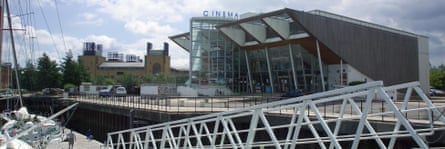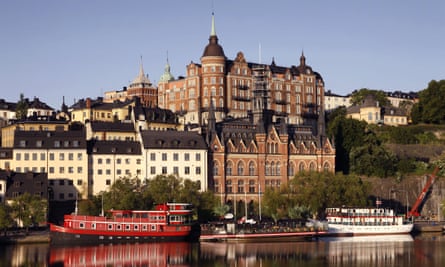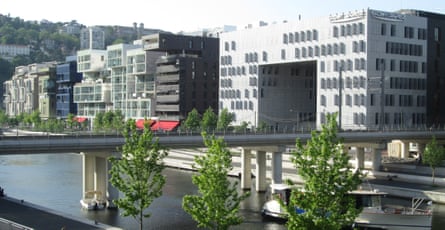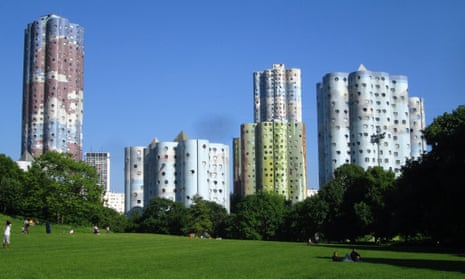A couple of days after the result of the Brexit referendum, I visited Southampton, a medium-sized port city on England’s south coast. It had, to my surprise, voted to leave the European Union, and by roughly the same margin as the country as a whole: just over 50%.
A rainy walk ended at Ocean Village, a development built in the mid-80s on a small, derelict part of the city’s docks, which are mostly still in use. Formerly on the site was the late-1940s Ocean Terminal, a streamlined design for the luxury travellers for whom Southampton was a more long-winded precursor to Heathrow. That was demolished in favour of a miserable collection of pitched-roof housing complexes in cul-de-sacs and vaguely postmodernist office blocks surrounded by car parks, as well as an American-style exurban multiplex cinema and shopping mall. This latter was one of several car-centred, big-box malls built in the city centre since the 1980s. The mall was demolished after less than 20 years and replaced with a skyline of extremely dense luxury flats along a boardwalk, packed tightly together so not a penny’s rent goes uncharged.

On a map, you can see a peninsula jutting out into Southampton Water, the estuary that leads to the Solent. But there’s no view of the estuary here for the public. Amazingly, the designers of the executive housing estate here managed to create the same sort of insularity you’d normally find on the city’s outskirts. There’s one place you can see out to the sea – a hard-to-find corner, through a fence marked RESIDENTS ONLY.
In 1995, a new building was opened there: Harbour Lights. Here was a building that was elegant, confident, oriented towards the water rather than to a parking space, and, most of all, a building that felt European. It was one of several buildings, often on watersides, that were the harbingers of a “Europeanisation” of urban space in Britain. Bradford would be an Italian hill town, Gateshead would be the new Bilbao, Salford would become as outward-looking as Rotterdam, Sheffield would model its public spaces on Barcelona. Each one of these places voted in the majority to leave Europe. What went wrong?
Indefensible missteps
It is hard to recall how insular and grim mainstream British architecture was in the 1980s. Urban redevelopment schemes well up until the late 1990s were pinched and anti-urban, defined – no matter how central or dramatic the site – by cul-de-sacs, squat mock-Victorian offices and endless surface car parks, all of it based on a paranoid and misanthropic notion of “defensible space”.

It is astonishing now that the architects of Ocean Village did not want to emphasise the bridges, ships and silos of Southampton Water, but this was the norm at the time. You could find similar stuff in Salford Quays, inner-city Liverpool, London’s Docklands or along Bristol’s Floating Harbour.
The contrast with European architecture of the same decade is remarkable. There was a reaction to modernism everywhere on the continent in terms of its aesthetic and the blocks-in-space approach to planning, but the way this was manifested in Britain was out of sync with the rest of Europe. In Berlin’s IBA, in Palomeras in Madrid, in late-Soviet Riga, in the inner suburbs of Paris, in Södermalm in Stockholm, the decision was to turn to the 19th-century city-block structure, with shops and cafés on the ground floor, flats above and semi-public courtyards between. The results were modern and urban.

At some point in the 1990s, British politicians – mostly Labour – noticed the enthusiasm that British planners and architects had acquired for the European city. From their visits to Barcelona and Copenhagen sprang a thousand pavement cafes, gamely placed on drizzly street corners. In emulation of François Mitterrand’s Grands Projets, Arts Council England, armed with National Lottery funding, lavished cash on the likes of Southampton’s Harbour Lights.
Designed by the firm Burrell Foley Fischer, the building was a shift to the modernity the city had abandoned in the 1980s. Glass, steel and wood, jutting out in vaguely nautical fashion to provide public views, it was also a rare new building for culture in a city which had otherwise devoted itself to becoming a giant out-of-town mall for Hampshire suburbia. In many places you wouldn’t look twice at it, but here it seemed to suggest a different kind of city. Yet the new high-rise luxury flats, going up at the time of writing at the other side of Ocean Village, tell the story of why this vision was rejected.

In 1992 Penguin Books and the Labour party co-published A New London, a collaboration between the then Labour shadow minister for arts and media, Mark Fisher, and Richard Rogers. Britain’s dilapidated streets and pretty new developments were contrasted with Europe’s openness, cleanliness and experimentation. This was the blueprint for everything the Urban Task Force would do from 1997 to 2010 under Rogers, who promised nothing less than an Urban Renaissance. What Rogers and his ilk failed to grasp was that Europe was becoming more like England, privatising and paring back its public commitments under the soft-neoliberal commands of the Maastricht Treaty – only it was doing it far more slowly and peacefully, maintaining a level of quality control and order.
The new Europe built under New Labour was a facade and never really made it into everyday life, into council estates and suburbs, other than when the former were demolished to make way for something more “aspirational”. If the centre of Manchester became like a cheaper, rainier Barcelona, its suburbs and satellites remained resolutely part of 80s England, with all the retail parks, developers’ housing, and dreary jobs that entailed. Lottery-funded arts complexes couldn’t replace skilled work, secure housing and a sense of purpose.
In Britain, the experience of Europe has been for the lucky few. Like so many adoptive Londoners, I find the Britain promised by Brexiters quite terrifying – xenophobic, paranoid, enclosed, nostalgic and cruel.

On that visit to Southampton, I got into a passionate argument with my mum, who had been among the 54% of people in the city to have voted leave. She couldn’t bear to vote for membership of the “bosses’ club” that is the EU, especially after what it had done to Greece, and believed that its clauses enshrining balanced budgets made any leftwing programme impossible. I was unconvinced by these arguments. But at the heart of my own response was something quite irrational: the reason I wanted to stay in the EU was architectural.
Wasted potential
The previous year, I’d been on a commission to write about contemporary European cities in the lead-up to the referendum. Many of them were of the same sort of size as Southampton, with similar histories and economies. Yet I have still not seen anything quite like Ocean Village. In most of Europe, a city like Southampton – medieval and multicultural city with a varied and interesting architectural heritage, two universities and an affluent, educated population – would never have imagined building something like this.
I have never seen in continental Europe an example of planning failing so utterly, the assets of sea and historic city wasted so totally, a visual sense atrophied so completely, and urban qualities ignored with such aggressive philistinism. Despite the “waterside regeneration” on show at Ocean Village, I held on to the belief that, perhaps through ease of travel to France, the Low Countries, Spain, Germany and the Baltic, we might have taken on just a little of these places’ ideas, and that their ease may yet become the norm here.
There are a few places where I’ve most felt “Ah, this is Europe, and this is better.” The “Islands” in Lyon, where the quays at the confluence of the Rhône and the Saône are now lined by modern, elegant apartment buildings, with chic public spaces and even – that shocking thing – a well-designed shopping mall; the centre of Zagreb, with its horseshoe of parkland looping around turn-of-the-century buildings of just the right amount of battered grandeur; the seafront at Trieste, a sort of anti-Southampton, with everything looking right out at the water.

Aspects that are routine to varying degrees in Europe include: a housing system where property ownership does not dominate and decent social housing is normal, accessible and cheap; a lively culture of architectural debate; an integrated, publicly owned networks of tubes, SBahns, trams and trolleybuses, with elegantly designed stops, stations and carriages; research and training taking presence over casual work; an integration with trees and nature; cycle paths as a basic good, with cars banned in some central areas and strongly curbed everywhere else; a free education system; universal childcare; universal health care; an approach to the buildings of the past that is based on conservation rather than conservatism; a decentralised system of local government, whereby provincial cities and regions don’t have to go cap in hand to the capital whenever they want to electrify their railways or build a tram line; streets and spaces that flow easily into each other, making walking a pleasure, rather than breaking them up with fences, spikes and CCTV cameras.
However, when you make Europe into an exemplar you’re connecting yourself with a long and disreputable history of exceptionalism. As soon as you venture much further out of the places that have their entry in Most Liveable Cities articles, you’ll find another side to the continent and the cities. The European city is not merely the social city, dense, historically rich, egalitarian, clean, walkable and dominated by public transport, it is also the city of the nation-state: a European invention that has caused countries all over the world to reshape themselves – or be forcibly reshaped – in its image.
- This is an edited extract from Trans-Europe Express by Owen Hatherley, published by Allen Lane.
Follow Guardian Cities on Twitter, Facebook and Instagram to join the discussion, and explore our archive here
